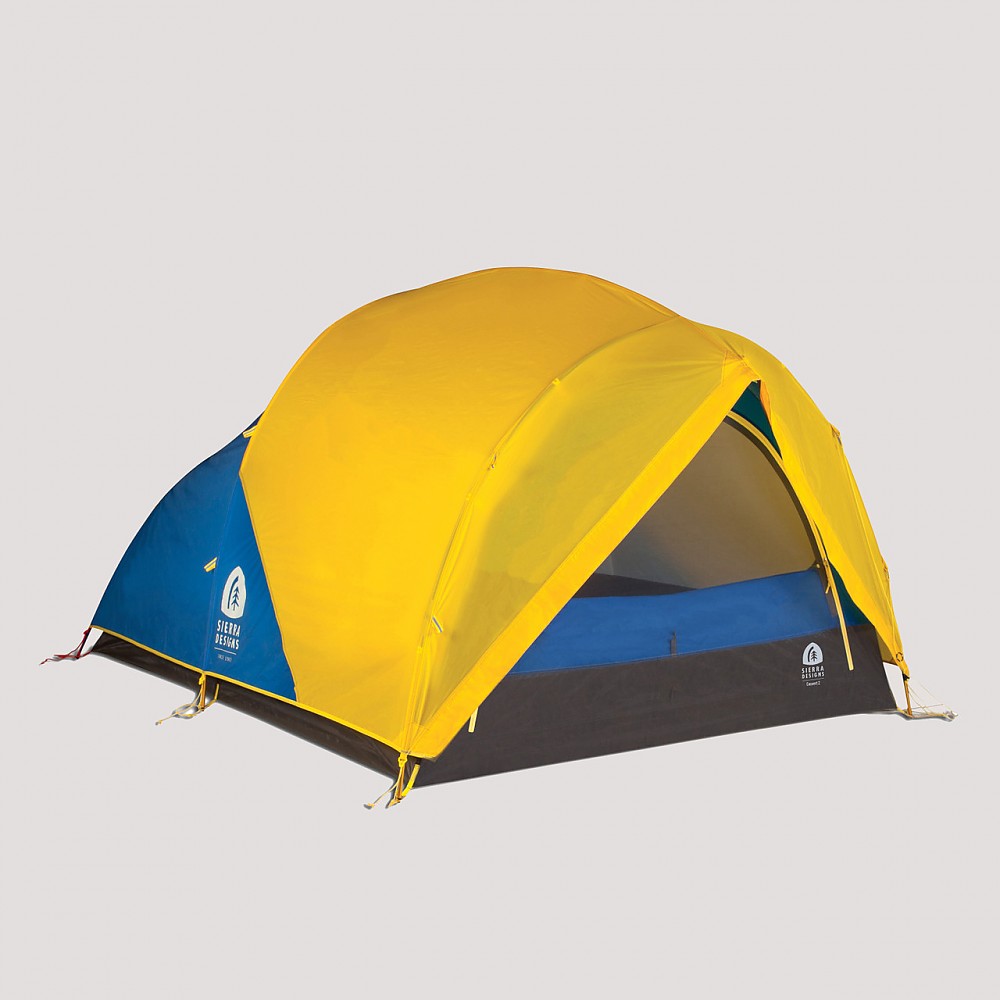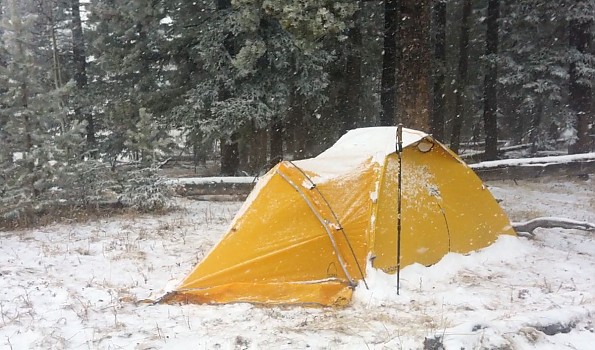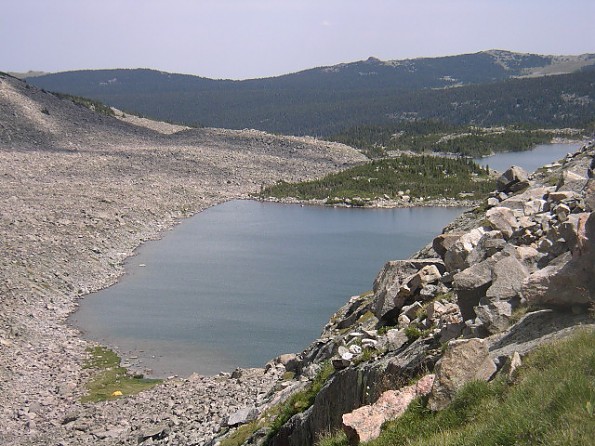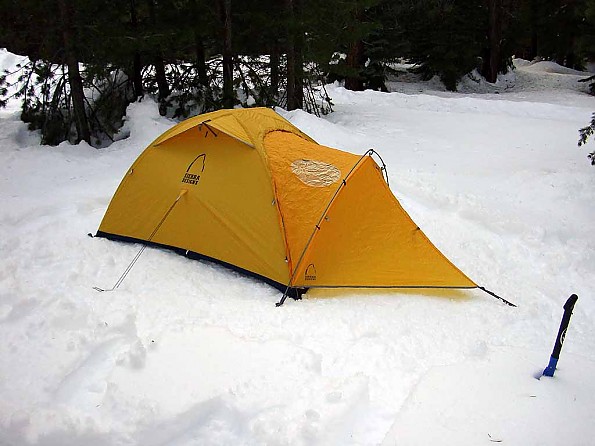Sierra Designs Convert 2

This tent is very packable and totally weather proof regardless of what you're up against, and I've lived it all in this tent. The removable vestibule is ample for 2 packs, or to cook in, or for the dog and some gear (I've used it for all 3). NO condensation issues typical with some single wall tents, as its 2 upper vents provide ample ventilation. If you leave the vestibule at home to save weight, you still have total weather proofness and the advantage of star gazing from the comfort of your sleeping bag.
Pros
- Light and packable
- Totally weather/bomb-proof
- Very easy and fast to erect
- Great ventilation
- Jakes Corners - WOW
Cons
- Not the best for hot summer days unless you skip the vestibule
- A little tight for 2 and gear

I've used my Sierra Convert2 mostly in the mountains and foothills west of Calgary, Alberta, Canada. This is an area of extreme temperatures and conditions, often in the same day. The Convert2 is at home wherever you decide to put it. Its small footprint and ease of use, makes this tent my go to shelter when the conditions are harsh or questionable.
The Convert2 comes with an awesome attachable Vestibule, Jakes Corners (small braces placed at each corner for ultimate stability when things really get hairy) a BRIGHT yellow DriZone breathable skin, and everything you need to make this shelter your home away from home - only smaller - much smaller.
The vestibule can be used or left in the pack (or home if you know the weather will be great). With the vestibule attached, the added square footage is welcome as you can store your packs, footwear or other gear with total confidence it'll be there safe and dry when you wake up.
The extended floor flaps on the vestibule allow you to flare the base and add weight with either wood/rocks or snow in the winter. The vestibule simply zips onto an already standing tent and adds a seamless extended profile. A pre-bent DAC Featherlite shock-corded pole adds some rigidity and form while a single adjustable stakeout-point pulls it to full length.
The Convert2 also has 2 upper vents that are protected from the elements by "dormers" created from a single crosswise positioned DAC pole with ballcap-type connectors at each end. These connectors provide for a hard-tensioned wing-type structure, impervious to anything in mother natures arsenal. These ingenious "wings" catch refreshing breezes which not only bring fresh air into the tent, but also carry away condensation-causing body and breath moisture. The vents themselves are totally adjustable via netted and solid DriZone semi-circle flaps. The tents' DriZone skin is breathable so when tightly sealed, the tent can still manage some moisture control. I have yet to wake up to heavy condensation in this tent.
When fully staked out the you can add some extra shoulder room by utilizing the mid-height guy loops to pull the walls to a more vertical position. This does provide some additional space, and any additional space is welcome in this 2 person tent. With super bright reflectors located at various points around the tent, and its very cool reflector-material rimmed door, this tent is very easily spotted when things go dark.
I'm not a big fan of continuous sleeves when pitching a tent, but they do get the job done when superior structure integrity is required. This tent is designed for extreme conditions and all things being equal, the continuous sleeve system on this tent is the easiest I've seen.
Similar to some Hilleberg and other outstanding tents, the poles are fed into the sleeves from one end and fed through to an enclosed pocket at the far side. From here you to raise the tent by tensioning-bending the poles to create the final shape and locking the pole ends into the grommets at the front corners. As this is a single skinned tent, that's it! Simple. The Convert2 can even be pitched from the inside.
To add even more strength to the structure (rarely required but awesome to have), the Convert2 comes with Jakes Corners. (Don't ask me where the name comes from, I haven't got a clue). These ingenious little 2 section poles create a triangular structure at each corner of the tent providing incredible support to the main structural tent poles.
(Picture two ends of these shock-corded short poles locking into floor-pockets located a few inches from the corners of the tent on adjacent walls. The shock-corded center now meets at a 45 -degree angle where it is raised and locked onto the main structural tent poles with a special corner-forming clip. Voila, a Jakes Corner.)
Sounds complicated, but easy in practice.
This tent does not get the attention it deserves in my estimation. In reading all the reviews out there, I don't think I have come across any ratings less than excellent. After using this tent in all manner of conditions, I have to agree. What an awesome little tent. For the single user, its spacious and easy to carry. For a two person set up, it's a wee bit tight, but given what its intended use is, why would you want to make the footprint any larger?
It's not the best summer tent in low elevations as there is only the one door and 2 small vents, which will get the job done, but there are better solutions for that application out there. In my estimation, the Sierra Designs Convert2 is at the top of the food chain where it comes to single-wall 2-person, 4 season tents.
Source: bought it new
Six nights only I spent in this tent during the summer, but since virtually no one else has written a review on it, it is time for someone to weigh in on the Sierra Designs Convert 2. My experience was sufficient for me to have something to say. I used it in the Rockies at 2800 meters and 3100 meters during July of 09, which means relatively low humidity and cool, but not cold temperatures. My first impressions of this tent are excellent, and I am already thrilled I bought it.
The tent is roomy enough for two men 1.85 meters and 75 kilos each. If you are taller than 1.9 meters, then this tent is going to start feeling a tad short for you. There is a little extra shoulder room at the head (near the door) for the necessities that you need; the tent tapers toward the feet to save weight. There are a couple good internal hanging mesh pockets, and additional fabric loops on the inside, which certainly could be used for a larger gear loft or two, but which can be used for internal guylines to strengthen the tent in extreme conditions--something I have never heard of before, but a great idea.
Set up was a little tricky the first couple times, as you need to figure out which poles do what, and how to thread the two main poles so as to raise the canopy. I don't remember if this tent is advertised as freestanding, however, the tent without the vestibule is freestanding: it can be set up without stakes, and is taunt. If you are backpacking solo however, during set up, it is really a help to stake down the tent first, thread the poles all the way in, and then with arms spread wide and a pole in each hand, to push on both poles simultaneously from the head of the tent in order to raise the canopy.
The ridge pole which holds open the venting “fly” (which I call the “minifly”) on the very top of the tent is extremely difficult to remove: it is simply strung too tightly. No amount of snow which might build up on the minifly would ever collapse that pole. (It seems to me that Sierra Designs could have shaved another ounce by creating that pole at only half its present diameter. It is possible that Sierra Designs corrected this problem for 2010; I cannot tell from their website. They did make some changes.).
I had to stare at the instructions and the Jake's Corners themselves for a minute or two before I figured out how they worked, but they would seem to me to be an ingenious and significant contribution to tent strength. Inside the tent, I locked one corner with the JC and then pulled inward on that pole, exerting a lot downward pressure on it, and the Jake's Corner was not about to let that pole deflect. I was really surprised at how firm it was. Reminded me of JC's story of the house built upon the rock: when came the storm it stood firm.
Outside the tent there are also numerous (seven at least) additional guyline loops which, like the Jake's, are unnecessary in normal conditions, but which would allow you to really anchor this baby down in the strongest winds. Sierra Designs also makes an internal guy kit, which if you also used, along with the JCs, you would have nothing less than a fortress. Strength is one of this tent's fortes.
The Convert 2 has no rainfly: it is a single wall tent. As for myself, I was concerned about ventilation and condensation. So my first night in, experimentally, I zipped up the door all the way, and zipped shut the two covered, ceiling vents (which have both mesh and fabric closures, which are separate), to put the breathability of the Drizone material to the test. About the only conditions in which someone might want to do this would be at about 40° below in an all out effort to keep heat inside the tent. (In regards to keeping heat inside the tent, I sense that the Drizone material would do this better than the average tent with standard nylon walls, yet I might be wrong as it is only a single wall.) I awoke at about 4am and did sense a big need for some fresh air, but surprisingly there was no condensation inside the tent, even with two occupants on a still night. I unzipped the top two vents and zipped the door part way down, and immediately felt a fresh air flow, even though there was no wind outside.
Fortunately for this review, at my 3100m location, I got hit with a number of good rain storms and heavy winds. This tent never leaked a drop, and happily, no rain blew in through the open ceiling air vents under the minifly. Even when I touched the sides of the tent during the rain, they did not leak. There was no internal condensation during the rains, day or night. The air ventilation system really catches and channels air and seems to create a power ventilation system. I was very impressed that a tent of this general shape was so taut when no guylines were strung. In fair weather, you simply don't need them. The tent did make some rustling noise under some strong winds, and this noise decreased when I guyed out the sides and tightened the vestibule.
The tremendous blasts of wind I experienced pulled out a couple of the needle stakes (the ground was soft) and moved two 7 or 8 kilogram rocks I had used as anchors to guy out the tent sides. That is how strong the wind was. (80kph?) No damage was done to the tent, and the tent would have had so much more to give if I had guyed it out everywhere and installed the Jake's Corners. The tent of course will shed wind best if you are able to pitch it so that the door or the rear is facing into the wind. If you have a strong cross wind, you need to have the air vents open to allow the air to pass through the tent. If they are closed in a crosswind, the air will get trapped underneath the minifly and exert strong upward lift on the tent. So I suppose you will need to open the air vents at 40° below if you have 60 kilometer per hour cross winds. In short, in this tent I felt like I was sheltered from the elements: I was sealed in from the rain, and this tent can handle any wind I will encounter.
One really nice touch is the reflective piping. Once at night when I was trying to find my way back to camp in the forest with a dim headlamp, as I scanned the forest, my headlamp “shone” on the tent at about 50 meters out, and the reflective piping on the tent lit up like a Roman candle. Even with the headlamp, I would not have been able to have even seen the tent at that distance, if it were not for that piping, and would have walked way past camp and really wondered where I was.
The vestibule was really handy: when leaving camp to go fishing I just threw all my junk in there, and it was all out of sight and protected from rain. Contrary to another review on this tent, you CAN get two full-size backpacks into the vestibule if you pack them so that they will stand up and if you place them right by the door. With the vestibule in place, you can leave the tent door unzipped for excellent ventilation and even a little star gazing through the clear skylight patch on the vestibule.
One negative would be that without the vestibule (which zips off to stay at home), rain or snow will enter the tent while you do. Apparently, without the vestibule and the Jake's Corners, this tent weighs only 4 lbs 2oz. My advice would be that if you are traveling fast and light and far, breaking camp each day, leave those two at home. If you are going to set up camp in one place for a few days, or may face extreme wind, rain, or snow, take the vestibule and the JCs and laugh at the elements.
Let's summarize, negatives first.
CONS
Two minifly limitations:
1. With the ventilation flaps under the minifly closed (which would only be desirable in super cold temps), in a crosswind, the minifly will really trap wind underneath it, which will exert lift and pressure on the tent itself. (Head or tail wind, no problem.)
2. With the ventilation flaps and door closed, the air in the tent got noticeably stale overnight.
Without the vestibule, rain and snow, if coming from the direction of the door or coming straight down, will enter the tent when you open the door.
The ridge pole which holds up the minifly at the tent's crown fits way too tightly, and is very difficult to remove.
Construction gaffs: a small piece of fabric of the vestibule was accidentally sewn into the door zipper seam, and thus not separable from the canopy. A simple cut of a tiny slice of non-necessary fabric cured that. Also at one fabric juncture, a flap of material was not stitched together properly. Some SeamGrip took care of that.
PROS:
Door location: at one end. Better than one side door, as both occupants can get in and out without one having to climb over the other.
Strength: This tent withstood some ferocious wind, (80kph I am guessing) which I frankly think would have leveled most off-brand cheap tents.
Lightweight: Are there any other sub 2 kilogram tents at all that are this strong?
Waterproofness: nothing came in.
Low-condensation: I was surprised there was none on a still night with two occupants and the tent zipped up tightly. I attribute this to the Drizone material which, if not highly breathable, at least seems to do a good job of conducting moisture vapor to the outside.
Airflow: with the two ceiling vents open under the minifly, or with those open plus the door partway unzipped, the flow was wonderful.
Unprecedented Versatility: They say this is a four-season tent: I concur. Yet is is light enough and practical enough to take on any summer overnighter. I will use this tent all the time, everywhere, solo or with a partner, regardless of what kind of trip I am on, regardless of season, and regardless of conditions. I don't know of any other tent on the market about which I could say that. I found a winner.
(I apologize that this review is so long, however..in the spirit of JC, this is the kind of review I wish someone had written for me.)
Version 1.1
Design: Four-season freestanding mountaineering
Sleeps: 2
Ease of Setup: Slightly difficult the first couple of times
Price Paid: $280 ebay
Unable to find any reviews or stores that stock this tent I finally decided to bite the bullet and purchase this tent on pro form. After setting it up and analyzing many of the features I am very happy with this product from Sierra Designs. The DriZone material used in the single wall construction seems to be very durable and waterproof.
The first thing I noticed upon setting up the tent was the interior space, while many 2 person tents are sized for two people very close with no additional room for gear. This tent is a bit larger and therefore the perfect size for two people and all the gear often carried along in winter trips. The vestibule is an easy addition and adds plenty of more space to this tent(great for crampons, packs, etc.).
Another thing that impressed me about this tent was the ease of setup, simply slide the poles through the one way sleeves and lock them into the tabs and your tent is complete. There is nothing worse than struggling with set-up in high winds and a snowstorm (especially with double wall tents). If you are in high winds simply add the internal "Jake's Corners" I found these simple additions increased the tents stability greatly.
Another great advantage of this tent is the ventilation system. While I have yet to spend a night in this tent the ventilation system seems greater than most other 4 season tents. Additionally this tent features mesh on the vents and the door. This is a feature not found on most 4 season tents and increases this tents versatility as a true 4 season tent. (If you are not a fan of mesh or you want to use this tent exclusively as a 4 season cut it out)
I also found that this tent in the fastpack mode (no vestibule or jakes corners) is very lightweight and compressible which makes this a true 4 season tent.
For the money you will not be able to find a better truly versatile tent that is still strong in harsh 4 season conditions.
Pros:
Mesh increases versatility
Strong waterproof DriZone material
Jake's corners and internal guylines(optional) increase tents strength in high winds
Adequately sized for two people and gear
Lightweight and compact in fastpack mode
Price
Cons:
Cheap tent stakes included
Non-Reflective Guy Lines
Also recent winner of Alpinist Magazine's "Mountain Standard Award"
Design: 4 Season Single Wall Freestanding
Sleeps: 2
Ease of Setup: Very Easy
Weight: 4lbs fastpack 6lbs w/ vestibule and Jakes Corners
Amazing all-around tent for three-season and four-season backpacking.
Pros
- Weight
- Ventilation
- Ease of setup
Cons
- Interior hooks are only in middle
I love this tent! I was in the market for a four-season tent, but I do a lot of backpacking and wanted something of a decent weight. Any four-season tent that is light, is single-walled and has poor ventilation (what I found in my research). The Convert allows me to have a four-season tent, light enough for packing, and still usable during the summer too.
I've used this tent around the world in different rainstorms, snowstorms, and summer conditions. Absolutely love the versatility and the weight is a good balance considering it acts as a four-season tent. Good fit with plenty of space for two people and sit up room. The vestibule also has plenty of space for storage, cooking, shoes, etc.
As to the ease of setup, I love the it clips and that poles don't have to be fed through any holes. The clips are easy enough even with gloves. Furthermore, the fly is always attached, so you don't have to worry about quickly getting the fly on after setting up the tent; it's a unibody, but still double-walled.
If you'd like to see a more detailed review with footage of features, I made a full review on my Youtube channel. You can find that review here:
Source: bought it new
Price Paid: $625
I bought this tent solely due to positive reviews on condensation control and lightweight (for a four season tent). I spent several nights in this tent in sub freezing conditions in the sierra and had no condensation issues.
This tent comes in component parts. Because the vestibule zips off, you can better divide up the weight of the tent / poles between two carriers.
The main weight savings comes from sharing the component parts, or simply leaving some parts, such as the vestibule components and jakes-corner poles, at home.
This tent is very pole intensive. There are two long main poles, a long vestibule pole, a small air-vent pole and 4 small jakes-corner poles. When all the poles come out of the bag, it is difficult to differentiate and separate them.
There are plenty of guyline loops, although the included guylines are heavy and inferior.
This tent is difficult to put up / takedown. Even after several practice sessions at home, it is still not a quick process. The poles are very long and need to be threaded the entire length of the tent, then arched up into place.
This is a difficult task for one person in the snow / rain. Taking the tent down requires inching the pole and fabric to slide the pole out. Because of this, pitching and taking down the tent in poor weather was frustrating.
Once up, the tent is free standing, taught, roomy and easy to find in the dark (reflective trip and points).
I’m happy with this tent, despite some of the shortcomings.
Pros:
- Condensation control
- Component parts separate to distribute weight between two people
- Roomy
- Free standing
Cons:
- Difficult to pitch in bad weather
- Many poles of different sizes (all colored the same)
Price Paid: $400
Your Review
Where to Buy
You May Like
Specs
| Price |
MSRP: $499.95 Historic Range: $321.97-$599.95 Reviewers Paid: $280.00-$625.00 |
| Minmum Weight w/o Vestibule |
4 lbs 2 oz / 1.87 kg |
| Minimum Weight |
5 lbs 3 oz / 2.35 kg |
| Packaged Weight |
5 lbs 12 oz / 2.61 kg |
| Doors |
1 |
| Vestibules |
1 |
| Vestibule Area |
16.4 ft2 / 1.52 m2 |
| Floor Area |
30.3 ft2 / 2.81 m2 |
| Peak Height |
43 in / 109.2 cm |
| Dimensions |
84" x 55 in (head) x 49 in (foot) / 213 x 140 cm (head) x 124 cm (foot) |
| Packed Size |
15.75 x 7 in / 40 x 17.8 cm |
| Design Type |
Semi Freestanding |
| Number of Guylines |
8 |
| Stake Quantity |
15 |





